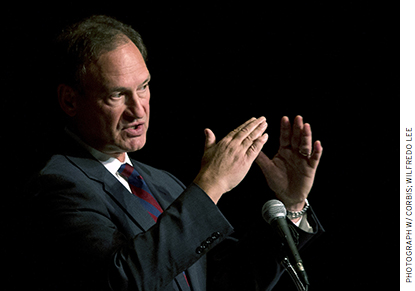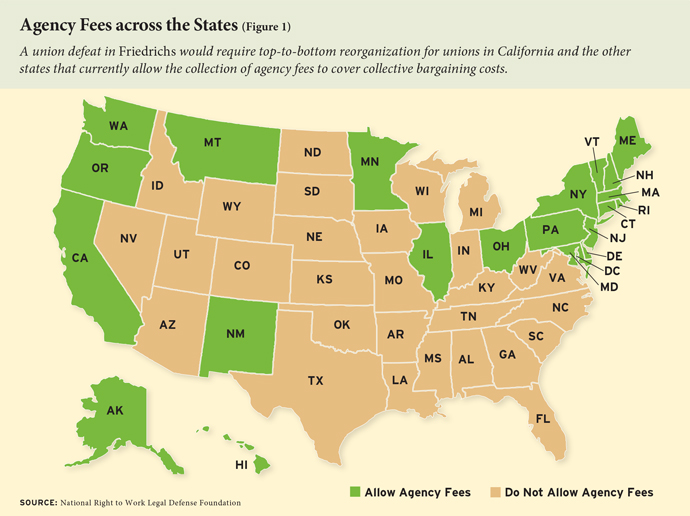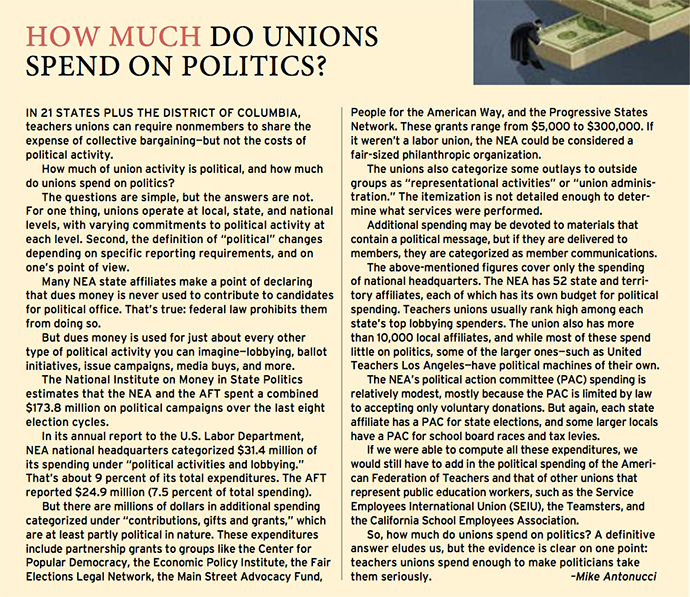 For 50 years, American education policy has often danced to the tune of labor realities. How much money is spent, and where, who is hired or fired, how we promote effective teaching, how we measure education outcomes, and more—all are affected by the relative power of the teachers unions at any given moment.
For 50 years, American education policy has often danced to the tune of labor realities. How much money is spent, and where, who is hired or fired, how we promote effective teaching, how we measure education outcomes, and more—all are affected by the relative power of the teachers unions at any given moment.
Now a case awaits hearing by the U.S. Supreme Court that could dramatically change this picture. The Far Left periodical In These Times calls Friedrichs v. California Teachers Association the case “that could decimate American public sector unionism.” Perhaps that’s simply an ideological overstatement. Nonetheless, the case, if decided for the plaintiffs, could end the practice of “agency” fees—money paid to the union by nonmembers in exchange for collective bargaining services. Unions call them “fair-share” fees and assert that their elimination would create a class of free riders, workers who would pay nothing while still enjoying the higher salaries and other benefits negotiated by unions.
The stakes for teachers unions are high, as a 2011 Wisconsin law illustrates. Wisconsin Act 10, known as the Wisconsin Budget Repair Bill, eliminated agency fees there and reshaped the collective bargaining process. Since the law’s passage, membership in the Wisconsin Education Association Council and the American Federation of Teachers-Wisconsin has fallen by more than 50 percent, according to a 2015 report from the National Education Association (NEA). In 2014, NEA membership in agency fee states grew by 5,300. In states without agency fees, it fell by more than 47,000.
Accordingly, at a conference of the California Teachers Association (CTA), the union briefed its activists on the potential consequences should the unions lose in Friedrichs, citing loss of revenue; fewer resources; decline in membership; reduced staffing; increased pressure on the CTA pension and benefit system; and potential financial crises for some locals.
The CTA may be overstating the possible consequences of Friedrichs. With a combined employed membership of about 3.5 million, the National Education Association and the American Federation of Teachers (AFT) collect agency fees from only about 130,000 workers nationwide. Their loss would not devastate the national teachers unions—but the unions have more to fear than that. To understand the potential for change, we need to delve into the legal foundations of the agency-fee system and how they work in practice.
From Abood to Alito
Decades of litigation and Supreme Court decisions have led to the current state of affairs in labor law, but for public-sector employees, the Supreme Court’s 1977 decision in Abood v. Detroit Board of Education holds sway. In that case, the Court held that no one can be forced to join a public-sector union as a condition of employment. Nor can one be forced to contribute to the union’s political speech and activities. However, in California and 20 other states, teachers unions are allowed to charge nonmembers a fee equivalent to dues to cover the costs of bargaining contracts, processing grievances, and other administrative activities (see Figure 1). The Abood decision upheld this practice.

In those 21 states, public school teachers must pay either dues or agency fees. Failure to pay is the only instance when the union will allow a school district to summarily fire a teacher. In fact, the union will demand it.
Unions assert that agency fees do not violate freedom of speech because the fee-payers are reimbursed a portion of their money annually, based on how much the union has spent on political and other “nonchargeable” activities. This assertion is being challenged by the Friedrichs plaintiffs, who counter that the agency-fee system is an infringement of the First Amendment rights to both free speech and free association. They maintain that collective bargaining in the public sector is itself inherently political: The union negotiates with a government entity, generally a school board representing local citizens. It uses the collective bargaining process to influence the amount and destination of tax dollars spent. Those who elect not to join that system should not have to cover its costs.
The filing of Friedrichs was timely, with the case working its way through lower courts just before dissemination of an opinion written by Supreme Court Justice Samuel Alito in Harris v. Quinn, an agency-fee case from Illinois involving home health-care workers. Although the Court’s 2014 decision did not explicitly overrule Abood, Alito did call that precedent “something of an anomaly.”
Alito addressed the weaknesses of the chargeable vs. nonchargeable system head-on. “Collective bargaining [in the private sector],” he wrote, “concerns the union’s dealings with the employer; political advocacy and lobbying are directed at the government. But in the public sector, both collective bargaining and political advocacy and lobbying are directed at the government.”
The justice called it a “bedrock principle” that “except perhaps in the rarest of circumstances, no person in this country may be compelled to subsidize speech by a third party that he or she does not wish to support.” Does that proviso foreshadow the end of agency fees?
The Threat to Teachers Unions
Clearly, a substantial number of education employees will choose not to join a union, or pay it a fee, if they do not have to. The unions lost members in Wisconsin, and if the plaintiffs win in Friedrichs, we can expect similar declines elsewhere. The NEA and the AFT know that mandatory agency fees provide a spur to join the union, and a loss in Friedrichs would eliminate that incentive.
The numbers confirm that. Consider two similarly sized teacher workforces. Minnesota is an agency-fee state with about 111,000 K‒12 employees, of which about 75,000 are teachers union members. Arizona, with no agency-fee law, has about 103,000 K‒12 employees and only 16,000 teachers union members. While Minnesota is more of a “union state” than Arizona, it’s a safe bet that Arizona membership would increase if that state allowed agency fees.
The cost of union membership is not insignificant. Local dues vary, but a typical California teacher pays $1,000 or more annually, and a fee-payer, about $650 after reimbursement of nonchargeable costs.
Given a difference of just $350, many teachers decide to join the union for the additional benefits—legal protection if threatened with suspension or dismissal, for example—offered exclusively to members.
Additionally, many teachers are pressured to join by union representatives and colleagues. Combine the carrots and the sticks, and a $350 annual savings loses its appeal for some.
Without agency fees, unions must expect to lose revenue not only from current fee-payers but from those reluctant members who decide to jump ship. Further, the elimination of mandatory fees might weaken the stigma currently attached to employees who forgo union membership.
At least that is suggested by the sharp decline in union membership in Wisconsin since the enactment of Act 10. If the losses there were played out nationally, the NEA and the AFT and their affiliates could conceivably lose as much as a half-billion dollars each year—close to one-third of their combined budgets. That is the kind of financial blow that unions can ill afford to bear, if they want to maintain their standing in state and national politics.
Agency-Fee Reality Check
When the Supreme Court reviews Friedrichs in its 2015–16 term, the justices will wrestle with the concept of agency fees as a way to balance the respective rights of unions and nonmembers. The Court will also consider the legality of the current “opt-out” system of union membership. At present, to become a fee-payer a worker must resign from the union and object to the use of any fees collected for nonchargeable activities. Some unions try to limit the time period during which a member can resign, though this tactic is often litigated to the union’s detriment.

Agency fees are typically extracted from a worker’s paycheck. The union places the nonchargeable portion of the fee in an escrow account, and each year the worker receives a check (with applicable interest) as reimbursement.
What defines an activity as chargeable or nonchargeable? This question consumes the time of union staff, attorneys, arbitrators, fee-payers, and other interested parties. Simply stated, according to the standard notice the unions must send to fee-payers each year, the fee “shall cover the cost of negotiations, contract administration, and other activities of an employee organization that are germane to its function as the exclusive representative.”
Public-sector unions are required each year to notify fee-payers in detail about expenditures and how their chargeability was determined. Union staffers code their own activities in categories that are defined as chargeable and nonchargeable. Union attorneys determine which actions are political in nature. The NEA classifies its activities as follows:
Chargeable activities: collective bargaining; preparations for strikes; grievance processing; “communications with bargaining unit members regarding services they receive”; professional development; NEA award programs; union “leadership and management skills training and techniques; and costs associated with the union’s representative bodies.”
Nonchargeable activities: lobbying and ballot initiatives; external public relations; litigation, “unless specifically related to collective bargaining, contract administration or organizational maintenance”; get-out-the-vote activities; contributing to charitable, religious, or ideological causes; supporting political organizations or candidates for public office; organizing or recruiting new members and “defending against challenges to exclusive bargaining representative status”; and “monitoring and opposing activities of groups and individuals whose purpose is to undermine public education.”
These groupings seem clear-cut, but in practice the lines are blurred.
For example, the costs associated with the unions’ representative bodies are chargeable to fee-payers because they cover activities related to the governance and administration of the union. However, conducting union business—some of which is political in itself—is not the only activity taking place during a meeting of a representative body. At the annual NEA Representative Assembly, delegates are solicited for contributions to the union’s political action committee (PAC). In fact, the NEA collects the bulk of its national PAC money during that four-day event. Fundraising is constant, auctions and raffles are held, and the most generous contributors are lauded from the podium. So, while fee-payers do not contribute to the PAC, their fees help make this PAC fundraising possible.
Member communications is another area where the lines are fuzzy. The unions hold that they are entitled to communicate with members on any subject without such communication being considered a political activity. That is a defensible stance, but the unions also maintain that communications to anyone in a member’s family also falls under that protection. Such thinking makes the question of chargeability very murky.
Fee-payers do have an opportunity to object to the union’s calculations—by participating in a hearing before an arbitrator, who is paid by the union. The documents related to the union’s calculations are presented to the objecting fee-payers on the day of the hearing. The complainants have no independent means to verify the data, and arbitrators rule in favor of the union in nearly every instance.
Fee-payers can then take the union to court, on their own dime and their own time. As the unions will attest, public school teachers are short on both.
The fee-payers want out. Why stop them?
The Magic Words: Exclusive Representation
The unions’ argument in favor of agency fees runs as follows: As the exclusive representative of a group of workers, the union is required by law to represent all workers in the bargaining unit, not just members. Since there may be costs associated with representing nonmembers, it is only fair that those workers bear their share of the burden.
“No one is forced to join a union—that’s already illegal,” said Michigan Education Association president Steve Cook. The banning of agency fees “allows workers to get out of paying their fair share of what it costs to negotiate the contract they benefit from. Whether proponents call this ‘right-to-work’ or ‘freedom-to-work,’ it’s really just ‘freedom-to-freeload.’”
That’s a pretty strong argument, as far as it goes. Wouldn’t a Friedrichs defeat for the union effectively force CTA members to subsidize benefits for nonpaying employees? Perhaps, if the state government or the local school district were forcing the CTA to be the exclusive representative of all bargaining-unit workers. But it is the union that demands exclusive representation.
That’s not to suggest school districts are clamoring to rid themselves of dealing with exclusive representation. Much case law references the need for “labor peace” and the avoidance of conflicting employee demands. And yet, almost all employers in the private sector, and those in the public sector in half of the states, manage to operate without exclusive representation.
In any event, California law clearly states who has the basic right to represent a public school employee—the worker himself or herself. If the employee doesn’t want to represent himself, he can choose someone to do it for him. California Government Code states these rights as follows:
· Public school employees shall have the right to represent themselves individually in their employment relations with the public school employer, except that once the employees in an appropriate unit have selected an exclusive representative…an employee in that unit shall not meet and negotiate with the public school employer.
· Employee organizations shall have the right to represent their members in their employment relations with public school employers, except that once an employee organization is recognized or certified as the exclusive representative of an appropriate unit…only that employee organization may represent that unit in their employment relations with the public school employer.
Note the “exclusive representative” exception in both of these provisions. Exclusive representation prevents individuals from negotiating the value of their own labor and from selecting their own agent.
Federal law does not spell it out quite so directly, but federal employees “have the right to form, join, or assist any labor organization, or to refrain from any such activity [emphasis added], freely and without fear of penalty or reprisal, and each employee shall be protected in the exercise of such right.”
How do workers end up with exclusive representation? The union files for that status with the state labor relations board. It must show it has the initial support of 30 percent or more of the proposed bargaining unit, at which point a representation election is called. In most states, a simple majority vote settles the issue.
That’s only democratic, right? It might be, if the district’s current teachers and support staff had actually participated in the vote. But most public-school union votes took place years ago. Many of those who voted for exclusive representation are now retired or deceased, and some current teachers weren’t even born when the vote was taken.
But they can always vote out the union, right? It’s not that simple. The same procedure for authorizing exclusive representation is used for a decertification election, but with more restrictions. Not only do workers need the initial support of 30 percent, but they have limited time in which to get it. If they manage to achieve that, they then have to face the full weight of their local, state, and national unions fighting against them.
The unions say the decertification process is equitable, but it is akin to telling someone who wants to fire his defense attorney that he cannot simply hire another, but instead must file extensive paperwork and complete a series of administrative and judicial procedures to have the first lawyer dismissed.
One Size Does Not Fit All
The unions defend agency fees on the grounds that workers who share in the benefits of union representation should help pay for them. This argument assumes that union membership benefits all workers.
On average, union teachers may enjoy better salaries and benefits than nonunion teachers, but many individuals make tangible sacrifices under union contracts. Math teachers make less than they might because the union insists they be paid the same as physical education teachers—even if there is a scarcity of math teachers and a glut of PE teachers. A teacher with seven years of experience makes less than a teacher with 10 years, regardless of relative skills, performance, or any other factor directly related to student learning. A teacher with a bachelor’s degree makes less than a teacher with graduate credits, even if those credits don’t measurably apply to the work.
A nonmember might well ask: If I am getting a bum deal as a public school teacher, should I be forced to pay the organization that negotiated that deal, and which was voted in by people who no longer work here?
A union spokesperson might reply that dues are to unions what taxes are to governments. We all pay taxes, even if we disagree with the use toward which they are put. We do not get to opt out of paying for the military, or the U.S. Department of Education, or the Federal Helium Reserve.
That’s a neat analogy, but a flawed one, because unions are not governments. They are private enterprises and have no more right to mandatory payments from individuals—enforced by school districts, which are agencies of the government—than do Coca-Cola, UNICEF, or the National Rifle Association.
A Post–Agency-Fee World
If the Supreme Court decides to strike down agency-fee laws nationwide, the NEA and the AFT would be forced to recruit their members one by one; additional teacher hiring would not automatically swell the unions’ ranks. In an open market, other organizations could compete for teacher representation, sell liability insurance, and offer professional services on a level playing field.
Still, one must take the rhetoric of union leaders and their media sympathizers with a grain of salt. A Friedrichs decision in favor of the plaintiffs would not spell the end of teachers unions. It would simply mean that the current situation in states such as Texas and Georgia would become the norm in California and the rest of the U.S.
While a union defeat in Friedrichs could place sharp limits on the political operations of the NEA, the AFT, and other public employees’ unions, the impact would be far from apocalyptic. In the states that do not permit agency fees, the teachers unions still have a hand in education policymaking. Unions there bargain collectively, if state law allows it. They lobby the legislature. They testify in committee. They speak at school board meetings. They campaign for and financially support candidates for public office. Some of the locals even have exclusive representation. They just can’t charge nonmembers a fee.
State and local unions in states such as California, Illinois, New Jersey, Ohio, and Pennsylvania are not accustomed to operating under such a regime and would require top-to-bottom reorganization. But those in states such as Texas, Virginia, Georgia, Missouri, and North Carolina would experience no change—except for diminished national subsidies from the NEA and the AFT.
Overall loss of membership is inevitable, but it would not happen overnight. The power of incumbency will give the unions some staying power, and they are already preparing for an adverse outcome from the Supreme Court.
CTA activists were shown a presentation at the recent Presidents Conference that offered an adaptive strategy. Titled “Not if, but when: Living in a world without Fair Share,” it recommended that local affiliates work now to induce fee-payers to join, to hold year-round membership drives, and to target younger employees.
The NEA’s Center for Organizing created a toolkit called “Engaging Members and Leaders in a Non-Agency Fee World.” It suggested that locals “group their membership by their level of support and engagement with the Association, ranking them from 1 to 4,” and then “consider a ‘recommitment campaign’ in which every member is visited and asked to do something public to demonstrate his/her support for the union.”
Every NEA member contributed to the production and dissemination of that toolkit, and every member will help pay for implementing its strategies. Will nonmembers have to pay for the “privilege” of being lobbied to give up their status? No expenditure list provides that level of detail, but unions are allowed to charge fee-payers for “communications with bargaining unit members regarding services they receive,” even though they are barred from charging them for “defending against challenges to exclusive bargaining representative status.” Should the unions themselves be in charge of making the distinction?
In an ironic twist, the teachers unions are allowed to charge fee-payers for litigation “specifically related to collective bargaining, contract administration or organizational maintenance.” Assuming that the union places its litigation of Friedrichs in that category of activity, it would mean that agency-fee payers are contributing to the union’s defense against ending agency fees.
Over time, a post-Friedrichs world would pose challenges for district administrators, school boards, and the public. Some districts might retain exclusive bargaining, though nonmembers would pay nothing. Others might have multiple unions representing teachers. In still others, all teachers might be free agents, able to negotiate entirely for themselves—as more than 93 percent of private-sector workers already do. Some school districts might see a combination of these scenarios—and new methods of labor relations might arise.
As for the unions, they could continue on as usual, enduring the financial hit but fighting to maintain exclusive representation, or they might decide to negotiate for members only, ending the whole “freeloader” problem with a single stroke. What appears to strike at worker solidarity might actually enhance it, since only those who voluntarily join will partake of the union’s voice and influence. The tent will be smaller, but it will be filled with true believers.
There would be opportunities as well for the public school system. Without one organization setting the labor policies for all education employees, there could be more innovation, more trial and error, increased differentiation based on need, and fewer restrictions on everything. Management can also get too comfortable with the status quo, even when it doesn’t work to its benefit. If the unions lose in Friedrichs, superintendents, district administrators, and school principals will need their own toolkit to operate in the new, non‒agency-fee environment.
But agency fees are just one of the tools of public-sector union power. Without them, the teachers unions will have to retrench. They are certainly not going to disappear.
Mike Antonucci is the director of the Education Intelligence Agency, which specializes in education labor issues.
This article appeared in the Winter 2016 issue of Education Next. Suggested citation format:
Antonucci, M. (2016). Teachers Unions at Risk of Losing “Agency Fees” – Friedrichs v. California Teachers Association could fundamentally alter the education labor landscape. Education Next, 16(1), 22-29.




